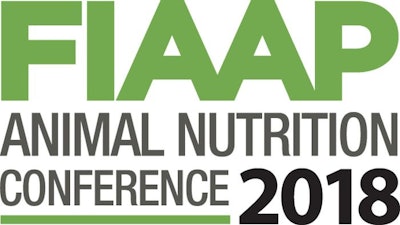
Throughout Asia, as in other parts of the world, livestock producers are looking to limit, reduce or eliminate antibiotics used for growth promotion (AGPs). In fact, according to the most recent WATT Poultry Nutrition & Feed Survey, 80 percent of respondents from around the world have instituted or are exploring some level of antibiotic-free production — with 22 percent citing that 100 percent of their production is antibiotic free.
The 9th edition of the FIAAP Animal Nutrition Conference aims to address antibiotic replacement strategies and other pressing issues facing today’s nutritionists and animal feed producers. The one-day event, to be held March 27 in Bangkok, will circle around several key topics: antibiotic elimination strategies, monogastric gut health, animal feed additives and alternative ingredients.
Antibiotic elimination strategies
While farm management is a key element, nutrition and feed additives play in important role in maintaining animal health and performance. During FIAAP’s antibiotic replacement strategy track, three presentations will tackle this topic from different angles.
As formulations change, feed producers are faced with the challenge of navigating feed processing with new feed additive products. “Reducing Antibiotics in Livestock Feed Through Feed Processing” will identify how proper manufacturing practices can deliver pathogen-free feed that is fortified with probiotics, prebiotics and other nutritional additives to promote gut health. Wenger Manufacturing UP/C technology manager Spencer Lawson will focus on the essential feed-processing steps for maximizing antibiotic-free feeds, animal health, pellet quality, feed conversion and palatability.
Eubiotic Nutrition combines modern nutritional principles with the use of non-antibiotic feed additives to create a status of eubiosis, a well-balanced microflora in the gastrointestinal tract. Consultant and nutritionist André Meeusen’s presentation, “Eubiotic Nutrition in Antibiotic-free Animal Production,” will explain the three key principles of the eubiotic nutrition concept. Meeusen will discuss how nutritionists can maximize nutrient utilization with multiple enzymes; improve fat digestion and nutrient absorption with lysolecithins; and how to obtain a healthy intestinal microflora using alpha-monoglycerides.
While there is already significant scientific data on the efficacy of bacteriophage therapy as a treatment of drug-resistant bacterial infections, the use of bacteriophages to prevent illness in food animals requires more research to further reduce antibiotic usage on farms. Proteon Pharmaceuticals founder and CEO Dr. Jarosław Dastych’s presentation, “Bacteriophage: Antibiotic-free Solution Against Salmonella in Poultry,” will outline the practical challenges and issues raised by the development and testing of a bacteriophage-based solution to prevent and/or treat salmonellosis in poultry. He will discuss development of a bacteriophage-based technology platform, which could be used to selectively eliminate most dangerous pathogenic bacterial strains in poultry, aquaculture and dairy, using a mixture of carefully selected and genotypically characterized phages that inhibit the growth of targeted bacterial serovars.
For more information or to register for the event, visit www.victamasia.com/registration.
FIAAP Exclusive: 2018 Nutrition & Feed Survey
For nearly a decade, WATT Global Media has reached out to its global feed and poultry audience to highlight the industry trends influencing animal nutrition and feed formulations. Kicking off the FIAAP Conference, Feed Strategy Editor Jackie Roembke will reveal the results of the 2018 edition of the Poultry Nutrition and Feed Survey and offer insight into the feeding shifts and challenges identified by survey respondents.

















